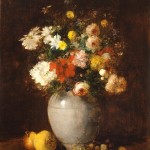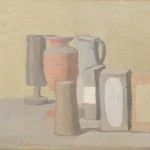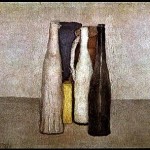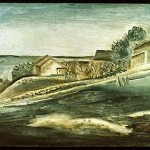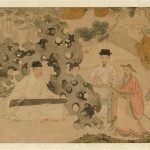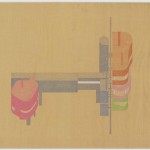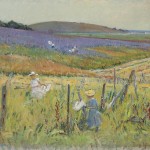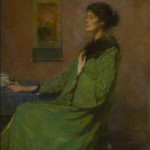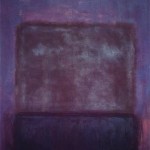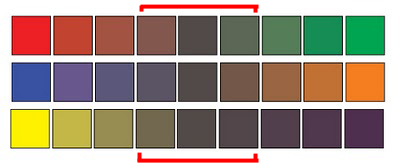Materials Needed
- all gouache paints from Supply List
- brushes
- ruler
- t-square
- pencils
- scissors, Exacto knife
- drafting or removable tape
- 9×12″ bristol
- color wheel
Discussion
- Poster for Learning Communities : Humument
- Student show prep
Lecture: Saturation
Color Concepts and Vocabulary:
- Saturation: Refers to the relative purity of a color.
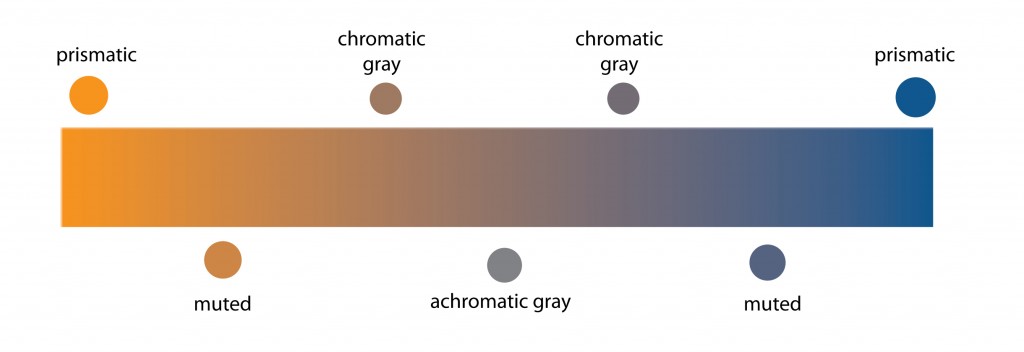
- Prismatic Color: As pure a hue as possible with pigments/paint.
- Muted Color: Colors that lie just outside the prismatic zone, created by adding black, white, gray or a complement of a hue.
- Chromatic Gray: Grays that exhibit a subtle, but discernible hue; created by adding larger amounts the complement and white.
- Luminosity: Refers to hue’s inherent light; lighter colors are more luminous than darker colors, but a lighter color is not necessarily more saturated.
- Primary Triad: yellow, blue and red, form an equilateral triangle.
- Secondary Triad: orange, green and violet; evenly spaced between the primaries; are mixed from primaries (example: red + yellow = orange)
- Complements: colors opposite on the color wheel.
In the traditional color wheel:- Red and Green are complements
- Yellow and Violet are complements
- Blue and Orange are complements
As designers, why is understanding and using Saturation important for communication?
- Packaging Design
- Graphic Design / Poster Design
- Broadcast Design
- Illustration / Animation
- Advertising Design
- Webby Awards: good place to explore career/academic study options
- Jacob Lawrence
- Jacob Lawrence
- Navy Poster
- Raiders of the Lost Ark
- sesame street by jonigodoy
- Works Projects Administration Poster
- Works Projects Administration Poster
- Works Projects Administration Poster
- Barack Obama – Hope
- Rosie the Riveter
- Antoine Vollon
- Giorgio Morandi
- Giorgio Morandi
- Giorgio Morandi
- Huang Ts Un-wu
- John Hejduk
- Theodore Wendel
- Thomas Dewing
- Thomas Woodruff Low Key
- Mark Rothko
- Thomas Dewing
- Georges Seurat
- Saturation Wheel
- Dark Chromatic Grays http://www.paintdrawpaint.com/
- chromatic grays
- chromatic grays http://www.dsource.in/
Critique
- Color Wheel FreeStudy
Lab
Chromatic Gray Studies
(NOTE: ONCE THE CONCEPTS ARE UNDERSTOOD, IT SHOULD NOT TAKE MORE THAN A FEW HOURS TO COMPLETE THESE EXERCISES.)
Prep:
- Prepare 2 pieces of 6×6″ square bristol using your pencil, ruler and exacto knife. This will be used for presentation only. You are making collages, so paint on scraps of bristol first, arrange, and then assemble/glue down on your 6×6″ square.
- Choose one of the following shape types, or invent your own!
- zebra stripes
- camouflage
- squares
Exercise #1:
GOAL: Make a 6×6″ gouache collage using at least six shapes with a BROAD VALUE range of chromatic grays.
All shapes should be chromatic gray (grays that exhibit a subtle, but discernible hue) with a BROAD value range (from light and dark) from a BROAD range of hues (R, O, Y, G, B, V). The white paper is not considered a color – the entire surface of your 6×6″ paper should be covered with paint.
- Use scrap pieces of bristol to create your painted paper shapes. Cut these out with scissors or exacto knife and assemble into a composition.
- Starting with a small amount of a Prismatic Color (Red, Blue, Yellow), add the complementary color (Green, Orange, Violet) to create a range of chromatic dark grays. Paint a shape with each dark chromatic gray.
- Then experiment by mixing your complements with more of one hue than the other.
(Example: mix 30% red with 70% green for a greenish chromatic gray.) - Then add white to each of your dark chromatic grays to create a range of lighter gray values.
- All the grays (light, midtone, dark) should have a subtle, discernible hue, but should lie closer to the center of the saturation spectrum (achromatic gray) than the end (prismatic color).
Exercise #2:
GOAL: Make a second 6×6″ gouache collage using at least six shapes with a NARROW value range (high, middle, or low key) of chromatic grays from a broad range of hues (R, O, Y, G, B, V). The white paper is not considered a color – the entire surface should be covered with paint.
- To make a low key composition, use your dark chromatic grays.
- To make a high key composition, your dark chromatic grays should be lightened significantly with white.
Mounting/Presentation: Arrange your shapes until you achieve unified compositions and then carefully glue down both compositions #1 & #2 on your 6×6″ squares. Then mount both on a clean, fresh piece of large bristol. Pay close attention to margins, craft, and cleanliness.
HINTS:
- High-key Example: Change the value by adding white to your chromatic darks.
To create a chromatic gray in high-key with a subtle yellowish hue, mix more Yellow with Violet and mix a small amount into a large amount to white. - Low-Key Example: Use your chromatic darks (without adding white).
To create a chromatic gray in low-key with a subtle hue of red-violet, mix a red-violet together with yellow-green. - Painting Tips: To prevent streaking, thoroughly mix paint before use, only adding enough water to get the consistency of cream/yogurt. Paint should be flat and opaque. No paper should show through.
- At the end of your painting session, apply extra paint onto scrap bristol for future use. Don’t waste your paint.
HOMEWORK
- Finish Chromatic Gray Studies #1 & #2
- Finished Studies should be cleanly and professionally presented- mounted on bristol.
- Post your work to the Class Blog. Don’t forget to comment on at least 3 other student’s posts. NOTE: the blog should have more space to post images shortly. If you missed any previous posts or comments due to this issue, please make sure to do them.
Print this page 










